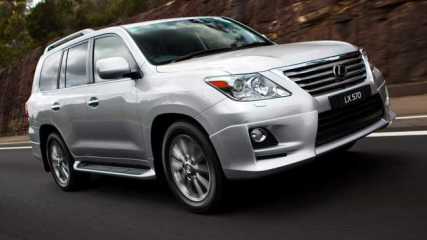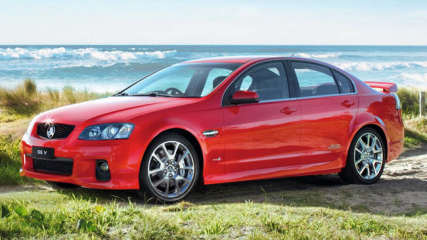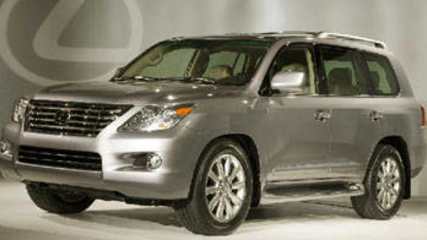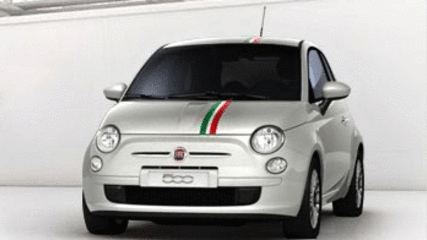Lexus LX470 News

Lexus LX 570 upgraded
Read the article
By Stuart Martin · 19 Apr 2012
The Lexus version of the 200 Series has follow the new GS sedan's styling lead but it brings with it a $9000 slice to the price and a boost for the features list.
On sale now and starting from $140,900, the updated LX 570 has been reduced to a single model and has styling tweaks front and rear, new 20in alloy wheels, daytime LED running lights, but Lexus says the main changes are under the skin.
The price cut narrows the gap to the top-spec Land Cruiser Sahara petrol V8 (albeit a 227kW/439Nm 4.7-litre) to $26,000.
The new 570 sits below the Range Rover petrol-engined line-up by $18,000, boasting extra seating capacity above the off-roading Brit.
The 570 undercuts the G and GL-Class Mercedes-Benz off-road brigade by between $21,000 and $33,000.
The outputs of the 5.7-litre petrol V8 remain at 270kW and 530Nm, with a 14.8l/100km combined-cycle fuel economy claim.
Changes to LX 570 are more than just skin deep, says Lexus, with the new off-road Turn Assist feature that reduces the turning circle by adding more brake force to the inside rear wheel - anyone who has driven a tractor will be familiar with this type of function.
The big eight-seater Lexus also has "Multi-Terrain Select" function, which allows the driver to select one of five terrain types (no doubt inspired by Land Rover's Terrain Response system) - rock, rock and dirt, mogul, loose rock, and mud and sand - to tailor the electronic control systems to the prevailing conditions.
The system also has four wide-angle cameras to show the driver what's going on in areas out of sight, displaying the images to the driver on the eight-inch LCD screen.
There's also a new display between the speedo and tacho that show front wheel angles, 4WD, speed and satnav info and the Crawl Control feature now has five preset speeds, up from three.
Standard fare also includes adjustable suspension, a chilled centre console, a dual-screen rear seat entertainment system, a reversing camera, keyless entry and ignition, four-zone climate control, daytime running lamps, 10 airbags, a 220-volt 100-watt power outlet in the rear cargo bay, a 19-speaker Mark Levinson sound system, front and rear clearance sensors and Bluetooth.
There's a $16,000 option pack that adds wheel-mounted paddle shifters for the six-speed automatic transmission, as well as the Lexus Pre-Collision safety prep system, active cruise control, rear seat heaters, ventilated front seats and mahogany wood grain-look interior trim, including on the steering wheel.

V8 cars are special
Read the article
By Mark Hinchliffe · 14 Jul 2011
Even at a time when fuel economy is top-of-mind with a growing number of Australian drivers there is plenty of space on the roads for Commodores and Falcons with old-fashioned V8 muscle under the bonnet. They burble menacingly at idle. They are the backbone of V8 Supercar racing.Yet V8s in the 21st century are not what they were in the days when they first conquered Mount Panorama and a GTHO Falcon or a Monaro - or even a Valiant V8 - was a dream machine for a generation of Aussie youngsters.Since 1970 the crude oil price has exploded from $20 a barrel to double that amount during the Iran revolution, over $70 during the first Gulf War, broke through the $100 barrier ahead of the Global Financial Crisis and has now settled at just below $100.In Australia, petrol prices have correspondingly risen from about 8c a litre in 1970 to about 50c in 1984 and almost $1.50 today.Despite all this, and despite one attempt at a death sentence by Ford in the 1980s, the V8 has not been wiped from Australian showrooms. Holden and Ford have continued to produce large cars with a V8 alternative and continue to slog it out at Bathurst.But Australian cars, even the ones that now have American V8s imported for local use, are not the only bent-eight blasters on the road.Germans are prolific builders of V8s and produce some of the most powerful engines in the world thanks to AMG-Mercedes, BMW and Audi. English V8s are built by Aston Martin, Land Rover and Jaguar, while the Americans provide V8s in the Chrysler 300C sold here. Even the Japanese luxury brand Lexus has a V8 in its IS F hero and its luxury saloon LS460, as well as the LandCruiser-cloned LX470.Most V8s are powerful enough breathing ordinary air, but there are many forced-induction models with either turbo or supercharging to liberate even more power. Walkinshaw Performance does the job in Australia for Holden, BMW is going down the turbo V8 road for its latest M cars and Benz had a time with a supercharged AMG V8.But V8s are not just about unrestricted power. The push for greater fuel economy has also reached V8 land and so Chrysler and Holden have V8s with multiple displacement technology which shuts down half the cylinders when the car is just cruising to improve fuel economy. Formula One racing engines now do the same thing when they are idling on a grand prix starting grid.Holden's Active Fuel Management (AFM) was introduced on the V8 Commodore and Caprice in 2008 and the red lion brand is committed to the engine - with future technology updates - despite near-record fuel prices."It is incumbent on us to keep it relevant and continue introducing new technology that delivers on our customers' needs," says Holden's Shayna Welsh.Holden has the biggest stake in V8s with more models than any other company selling in Australia. It has a total of 12 models with V8 engines across four nameplates and four body styles, including Commodore SS, SS V, Calais V, Caprice V and the recently introduced Redline range. V8s account for about one quarter of Commodore sedan sales and almost half of Ute sales."We see it as being more than just the V8 engine - it's about the entire car. It's the whole performance package that appeals to people and we want to continue making cars that people are proud to own," Welsh says."The combination of features and technology, great handling and braking and outstanding value is consistent across our V8 model range."Ford fans are also committed to V8s, according to company spokesperson Sinead McAlary, who says a recent Facebook survey was overwhelmingly positive."We asked whether they worry about petrol prices and they say 'No, it's the sound of the V8 we love and we are prepared to pay the price'," she says.Both Ford and Holden also have performance divisions where the V8 was, and still is, king. Ford's is Ford Performance Vehicles (FPV) and Holden's is Holden Special Vehicles (HSV).HSV marketing manager Tim Jackson says their sales are "on par" with last year."That's despite the fact that last year we had the limited edition GX-P which is an entry level product for us," he says. "We don't have that model in our range at all this year and you would expect numbers to come off, but we've been able to maintain sales volume."All of HSV's range are powered by a naturally aspirated V8 engine (6200cc 317kW-325kW), while the opposition at FPV has gained the kilowatt advantage with forced induction (supercharged 5000cc 315kW-335kW).Jackson says their LS3 V8 has been "validated" by customers."We're not getting guys screaming at us to go turbocharging. The LS3 is an extraordinary unit. It's a light engine with a good power-to-weight figure. There is not a turbo engine that would do it for us at the right development cost. But I wouldn't rule it (turbo) out or rule it in."Jackson says there have been no repercussions from the rise in petrol prices."Our customers don't have other choices in their repertoire," he says. "A small car doesn't suit them and they're not into an SUV. They're of a certain level where the whole cost of running the car is easy for them to absorb."The top-selling HSV is the ClubSport R8, followed by the Maloo R8, then GTS.However, the greatest HSV in history is debatable, Jackson says.HSV engineering boss Joel Stoddart prefers the all-wheel-drive Coupe4 and sales boss Darren Bowler the SV5000."The Coupe4 is special because of its engineering but I like the W427 because it's the fastest," Jackson says.FPV boss Rod Barrett says they are also experiencing strong sales growth. He says they sold about 500 cars in the first quarter, which is up 32 per cent on the previous year. He also says sales of the F6 have slowed since the launch of the supercharged V8 engine variants late last year, as customers "opt for power". Ford no longer offers a V8 with the demise of the XR8 sedan and ute last year."Our middle name is performance so we have all the V8s," Barrett says. "When we were launching this new supercharged car all the V8s came across here."Barrett says their supercharged engine has changed people's minds about "dinosaur V8s"."The turbocharged F6 was a cult hero car in its day and people thought a V8 was a low-tech dinosaur," he says. "But when we produced a high-tech all-alloy five-litre supercharged V8 built in Australia people started to think that V8s aren't all that bad after all. I'm not seeing the demise of the V8 just yet, but for us, the future is hi-tech."The supercharged 5.0Litre V8 335kW FPV GT continues to be FPV's top-selling vehicle followed closely by the supercharged V8 5.0 litre 315kW GS sedan and GS ute.Barrett believes the current GT is the best FPV car yet with its segment-leading power, light weight and improved fuel economy."However, I think our most iconic car was the 2007 BF Mk II 302kW Cobra in white with blue stripes. That car brought back the passion of '78 with the original Cobra. If you have a look at the second-hand prices, they are still holding up very well" he says.

Lexus powers up
Read the article
By Stuart Innes · 10 Mar 2008
Luxury car maker Lexus has distinguished its big four-wheel drive from the Toyota LandCruiser 200 on which it is based by installing a bigger V8 petrol engine.
The new LandCruiser 200 has a 4.7-litre V8 petrol engine capable of 202kW of power and 410Nm of torque or, at a premium price, a 4.5-litre twin-turbo V8 diesel giving 195kW of power and 650Nm of torque.
But the coming Lexus LX 570 version will have a 5.7-litre V8 petrol engine of about 270kW of power and around 530Nm of torque. This is 100kW more than the outgoing LX 470 wagon.
The big V8 will run to a six-speed automatic transmission with sequential shift.
The new Lexus is for people who want the tops in luxury yet with serious off-road abilities in a big and strong, yet comfortable wagon. And people who can pay for it.
The outgoing LX 470 has been listed at $123,000 and we can't see the new one with its extra technology being any less.
Although, for the first time, the Lexus LX will be offered in two grades of trim so buyers who don't want all the gadgets don't have to pay. Each version will have 10 airbags and vehicle stability system.
The upper-grade model will have a wide-view front-and-side camera monitor to help in parking and easing through off-road obstacles. A crawl control introduced on the latest LandCruiser 200 also will go into the LX. It helps when driving over rough surfaces by allowing the driver to forget about accelerating or braking, while concentrating on steering. The upper model might even have a power-opening and closing tail gate, commanded by the key fob and a cabin switch.
It will have adjustable height suspension, giving 225mm ground clearance, 31-degree approach angle and 23-degree departure angle in the top setting.
Expect the 5.7-litre engine in a big, heavy car to get through petrol. It has a 93-litre tank.

Look who?s torquing in 2008
Read the article
By Ashlee Pleffer · 04 Jan 2008
A hectic 2007 proved to be lucrative for the car industry with a plethora of new cars launched and more than a million sales throughout the year. And there's no indication that it will be slowing down in 2008.AUDI The new A4, to rival the 3 Series and C-Class is expected here about April, while July will see the hot sports wagon, the RS6 Avant and the A3 Cabrio. Extra A5 variants will follow. BMWBMW has a busy year ahead, starting with the 320d and 335i touring this month. The 1 Series Coupe will go on sale around April, followed by the convertible in May-June. But its big one for the year will be the new X6 Sports Activity Coupe, arriving between July and September. It comes with three engine variants, all twin-turbo, an in-line six, a 3.0-litre diesel and a 300kW 4.4-litre V8. Pricing is expected to start at just under $100,000. And the X5 scores a new engine in February, with the first variable twin turbo diesel offered in the range. CHRYSLER/JEEPJanuary will be a busy month for Chrysler, with the Sebring Cabrio and Grand Voyager people mover both arriving in Australia. The Jeep Cherokee will also get a total makeover. CITROENBased on the C4 Picasso, but bigger and better equipped, Citroen will introduce the Berlingo van between July and September, with a mainly diesel range. This will make room in the line-up for the new Nemo small van mid-year. The C5 will also get a new V6 diesel engine.FERRARIDeliveries of the exquisite F430 Scuderia, priced at about $550,000, will start mid year. Only about 40 will come to Australia and New Zealand. FIAT The reincarnation of the 1960s Bambino will arrive in March, but Fiat has already sold the first four months' supply. The new Fiat 500 will have three engine choices, a 1.2-litre petrol, a 75kW 1.4-litre petrol engine or a 56kW 1.3-litre turbo diesel. Pricing is expected to start from $22,000. The new Ritmo will join the Fiat 500 in March with pricing from $30,000. FORD One of the biggest launches for the year will be the new Falcon. Ford will release details of the new model in February and it's expected to be followed by an unveiling at the Melbourne motor show in the same month, with the official launch around May.FPV FPV will start the year with a new model, the hot turbo Territory, known as the F6 X model. It's the first non-Falcon model from FPV, with 270kW and 550Nm. The FPV Falcon range will also arrive this year. HOLDEN/CADILLACWith Ford's big year planned, you can't expect Holden to keep quiet. But so far, Holden has only announced it is expecting the VE Sportwagon, due in the first half of the year. GM-Holden is also introducing Cadillac with the first model due late in 2008. HONDA Honda will start the year with the new Accord model, due to be launched in February. The small Jazz is also getting an update after the middle of the year. Details on the new generation will be released closer to the launch. The Accord Euro is also expected to arrive later this year. HYUNDAI No big launches just yet, although an upgraded Sonata is expected mid year. JAGUARJaguar's major release for the year will be the new XF in June, with pricing expected to start from $105,000. It will be available in a V6 diesel, as well as a V6 and V8 petrol. KIAPreviewed at the Sydney motor show last year, Kia will launch its new seven-seater Rondo crossover in February. It is expected to start from as low as the mid-$20,000 mark. LEXUSNew for Lexus will be the LX570 around April or May, followed by the IS-F towards the end of the year. Details still to come. MAZDAThe second-generation Mazda6 will go on sale at the end of February with pricing from less than $30,000. It will be powered by a 2.5-litre, four cylinder engine, with 125kW and 226Nm.MERCEDES-BENZThe first arrival for Mercedes-Benz is expected to be the C 63 AMG in mid March. It will be followed by the S 320CDI, priced at $189,874 and the C-Class wagon, which will carry a $3000 premium over the sedan, coming in just under $60,000. MINIAnother new version of a 1960s cult car is also headed our way, with the Mini Clubman launched in February. The modern successor of the Morris Mini Traveller, the Austin Mini Countryman and the Mini Clubman Estate won't get into showrooms until March or April. Pricing will start in the mid-$30,000 area. MITSUBISHIMitsubishi will release two turbocharged Lancers this year. The top-level Lancer Evo X GSR will be here in April and sell for about $58,000. The 2.0-litre four cylinder turbo engine pumps out 200kW and 422Nm. Joining it will be the detuned version in the Ralliart all-wheel drive, at about $40,000. NISSANNissan's first addition for the year will be the all-wheel-drive wagon, the Dualis. Starting at $28,990 and stretching to $35,990, it's powered by a 102kW, 2.0-litre engine. PEUGEOTThe big launch for Peugeot will be the 308 replacing the 307 range, which will start with the 308 hatch in February in both petrol and diesel guises. The touring will follow in June or July, with the 308cc model a prospect for late 2008 or early 2009. PROTONProton has announced the Persona, based on the Gen2 hatch platform, will make its debut at the Melbourne motor show in late February, going on sale in March. It will be priced around the mid-teens. The Gen2 will also get engine updates and minor styling changes. RENAULTThe all-new Laguna will go on sale mid-year with a 2.0-litre diesel engine. SAABJune sees the arrival of the Turbo X AWD. SSANGYONGThe South Korean company will go completely diesel in 2008, with no more petrol engines on offer in Australia. SMARTThe new Fortwo arrives in Australia in February. The one-model brand will get both the 52kW and 62kW models, in hatch and cabrio, being bigger than the current models. SUBARUThe star WRX STi comes in February with a 2.5-litre turbocharged engine, although pricing is still to come. The third generation Forester arrives in March. SUZUKIFebruary's proving to be a busy month, with Suzuki also launching its Grand Vitara diesel. TOYOTAAfter a big year in 2007, Toyota is expecting a quiet year, with only the TRD Hilux due to be launched in April-June. VOLKSWAGENVolkswagen will kick off the year with the SUV, the Touareg R50, to be released in April. It's powered by a 258kW V10 TDI engine. The Tiguan also arrives about October. VOLVOThe recently launched XC70 arrives in showrooms this month, joined by the C30 diesel also in January. It's priced at $43,950. A base model C30 will also enter the line-up, at $34,450. A 3.0-litre six-cylinder engined V70 will arrive in March.

Lexus takes on baby market
Read the article
By Paul Gover · 07 Nov 2007
It will sit below the existing IS250 sedan and is aimed directly at the 1 Series, with a likely starting price below $50,000.The plan points to a compact hatchback body, rear-wheel drive and a range of sporty engines with the emphasis on six-cylinder power and refinement. But there is an equal chance that Lexus could head into the crossover field, making the newcomer a small all-wheel-drive wagon.The car is not officially confirmed, although Lexus executives are open in their discussion of the project.“I believe in the strong necessity to include an entry-level Lexus model,” the executive vice-president of Toyota Motor Corporation, Tokuichi Uranishi, says.“It's not decided. It's just an idea at this moment.”But it is an idea, which is already being welcomed by Lexus in Australia.“We are getting a lot of requests for that sort of car,” the head of Lexus in Australia, John Rocca, says.“And, looking at our competitors, there is certainly a market there for it.”Uranishi says a baby Lexus would help the brand to improve its average CO2 emissions, offsetting the poor scores of heavyweights including the LandCruiser-based LX, but Rocca can see other advantages.“What it brings to the brand is another model, for starters. And market share,” he says.“I think the advantage we would have is that, having the Toyota brand, there is credibility that we can build a car that size. Similar to what we have already experienced with SUVs in the brand.”Lexus is pushing hard in Australia with six models from the IS through to the upcoming change for the LX500.The heavyweight four-wheel drive is expected to be a star in 2008, lifting the current sales rate of 12 cars a month to more than 50. The improvement will also be helped by a two-level strategy to set a competitive price point against rivals including the BMW X5, Porsche Cayenne and Mercedes ML.Rocca says the new models are the key to Lexus's plans to fight BMW and Mercedes for luxury car sales leadership in Australia.“We've got a pretty aggressive business plan that we are putting through at the moment,” he says.“It's reliant on product, but we have to plan out to 2015. It will range from 16,000 to 24,000 sales a year."“Plans like that are driven by product. But in the short term it will be driven through the dealer network. We need to expand the network."“At the moment we're at 22 and by 2015 we'd like to be at 38 dealerships. Most of the expansion will be rural and we're trialling the Japanese image, which has been used for setting up the brand there."“We're adopting that in Australia as a trial in Perth. The first of the new-look dealerships opens there in January.”




